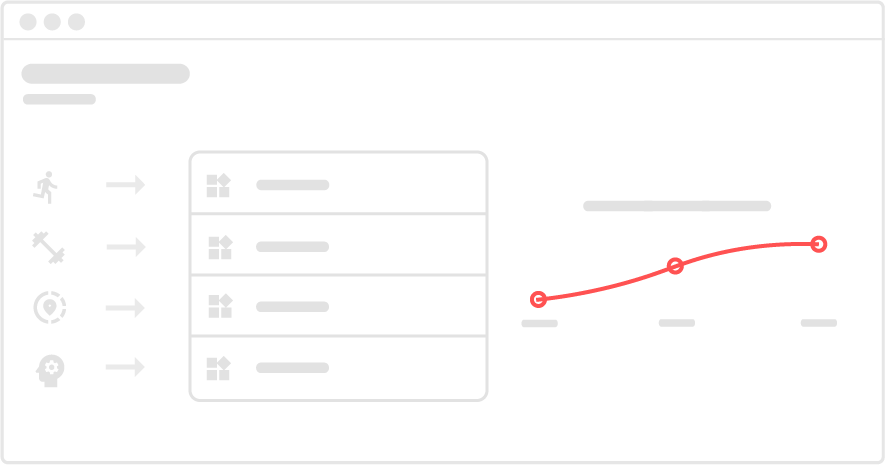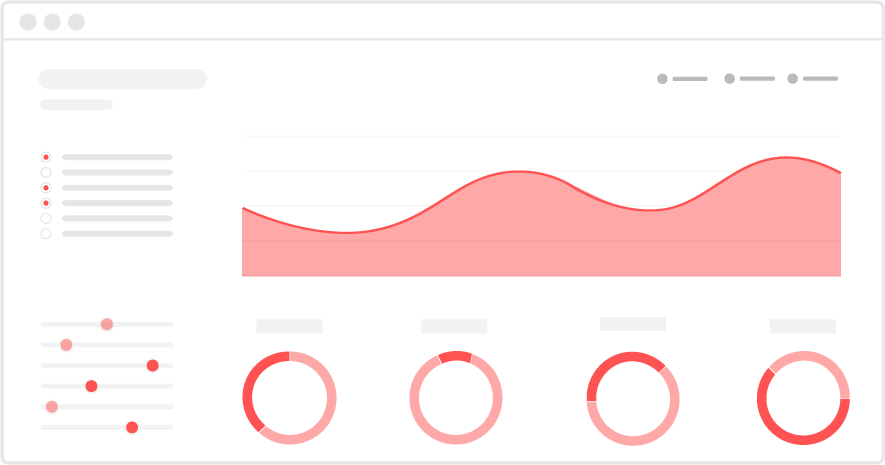Start here to get an overview of FYTT and to quickly ramp up the learning curve
FYTT is built for high performance professionals who need to design, schedule, and deliver individualized programming at scale without sacrificing quality. We've done our best to make the platform intuitive and easy to use. Below is an overview of the basic concepts and tools within FYTT. Familiarizing yourself with these features will help you quickly start delivering individualized programming to all your athletes.
COMPOSABILITY
The most important concept to remember throughout the software is that of composability. Think of the various objects in FYTT as components or modules that you can mix and match in order to compose your masterpiece. The smallest component is an exercise; exercises combine together to make workouts; workouts are combined together into sessions; sessions are combined together into programs; and programs are combined together into plans.
A general rule of thumb is to create smaller components rather than large, complex components when possible. This may not always hold true, but usually smaller components are easier to work with. They can more readily be combined with other components to create something complex when necessary, and it generally results in a better user experience for both coaches and athletes.
EXERCISES

FYTT allows you to create a database of exercise metadata that helps with automation and individualization. This metadata includes info like written and video exercise instructions, which body parts are used to perform the exercise, appropriate substitute exercises, and default KPI associations.
WORKOUTS

A "workout" within FYTT is a single, modular piece of a workout session. For example, within a given session, you might have a workout called "Warmup," then a couple workouts named "Upper Body" and "Lower Body," then a workout called "Cooldown."
You can create a database of workouts within your organization that can act as templates and/or puzzle pieces when composing sessions, progressions, and programs. Many users will populate their database with their preferred progression tables that they can later use to quickly build their programs.
SESSIONS

A "session" is a single bout of training composed of one or more workouts. You might generally think of it as a one or two hour training block where the athlete begins a session with a warm-up, practices some aspect of training, then ends with a cool-down.
The concept of sessions is used in two places: within programs and on the calendar. When designing a session within a program, the idea is that it will end up scheduled on the calendar at some point as a training block with a start and stop time.
CALENDAR

The calendar is your main point of entry for executing your training programs. From here, you can quickly view everything that is scheduled for a given week and access the tools you need to deliver training prescriptions to your athletes.
Making changes to sessions on the calendar is very quick and easy. So if something comes up and you need to adjust a session, you can modify anything on-the-fly right from the calendar.
KEY PERFORMANCE INDICATORS (KPIs)

A "key performance indicator" (or KPI) is a measure of an athlete's ability for an important training variable. This is usually an individual exercise (e.g., Back Squat 1RM), but can also be some sort of drill or series of movements (e.g., Pro Agility Drill).
Your organization can have a database of custom-defined KPIs that you track and use for training prescriptions. Most anything can be tracked in FYTT, but practically speaking, exercise-based KPIs are usually the only ones used to prescribe individualized training.
KEY PERFORMANCE VARIABLES (KPVs)
A "key performance variable" is a flexible construct that allows you to track important athlete characteristics, as well as record other variables that are relevant to your performance management framework.
This might be a physical attribute like body fat percentage, lean mass percentage, or body symmetry. But it could also be something completely subjective, like work ethic or rate of perceived exertion. KPVs are pretty open ended to allow you to track whatever is important to you.
KPVs could also be used to import data from external tracking devices, like velocity based training systems or force plates. The interface allows for a spreadsheet-like copy and paste transfer, so importing the data is a breeze.
ASSESSMENTS
An assessment is a collection of metrics that are grouped together within a given testing context. They are generally used to define the inputs for a particular testing protocol, and these inputs are then used to calculate an output using a formulaic KPI. Metrics in an assessment are grouped together on the roster for easy data input.
PROGRAMS

A "program" in FYTT is a collection of training sessions organized within a finite timeline (usually a few weeks to a few months). This most often correlates with the familiar concept of a mesocycle, but you are by no means limited to that framework. Programs are very flexible and modular, so you can build anything from individual progressions to full macrocycles.
Programs can be copied, cut, and combined together to make new programs. For example, suppose you have a common upper body routine that you like to drop into various training scenarios. You can create an isolated program for this routine, then insert it as needed into other programs.
Once a program is created, it can be scheduled on the calendar or organized within a plan. Programs are individualized to each athlete as they receive their prescriptions.
PROGRESSIONS

The progressions feature in FYTT is a powerful tool that enables you to quickly map out an isolated plan for adaptation within a program. For example, suppose a program has a track for "Upper Body" on Mon/Wed and a track for "Lower Body" on Tue/Thu. You can build a separate progression for each track within the program.
The point of progressions is to make it easy to create and visualize a model for inducing a specific adaptation within the context of the broader program.
PLANS

A "plan" is a calendar-based approach used to organize training within a specified time period. People often think in terms of an "annual plan," but you are not constrained to an annual timeframe. You can create plans of any duration, be it three months, twelve months, or four years.
Typically, the general idea is that a plan begins immediately following the last competition of the previous season, and ends after the last competition of the succeeding season. However, you can use plans in whatever context you prefer.
Additionally, the plan is not just an organization or visualization tool. Every session you implement within the plan is automatically synced to the calendar.
ROSTER
The roster is where the "athlete management" happens in FYTT. But by athlete management, we mean this is where you manage the data about your athletes that is used to generate individualized prescriptions. This includes KPI measurements, injuries, bodyweight, etc.

GROUPS
Groups allow you to organize your athletes so you can easily create multiple concurrent training paths. You can manually add athletes to groups from the roster, or you can add conditions to a group that will cause athletes to be automatically added or removed based on whether or not those conditions are met.
For example, if you wanted to create a functional movement screen based on assessments of certain KPIs, you could use conditional logic for various groups to automatically determine which training path athletes should follow.

INSTITUTIONS
An institution in FYTT allows you to manage multiple teams under one organizational umbrella. For example, a university olympic sport department might create an institution to manage all the teams it is responsible for.

FACILITIES

Facilities allow you to configure tablets for each station in your weight room, automatically assign athletes to stations based on abilities, and populate the tablets with each athlete's individualized workouts when you start a session.
REPORTS
Understand the cause/effect relationship between training prescriptions, training outcomes, and injuries so you can provide more effective, more individualized training.



